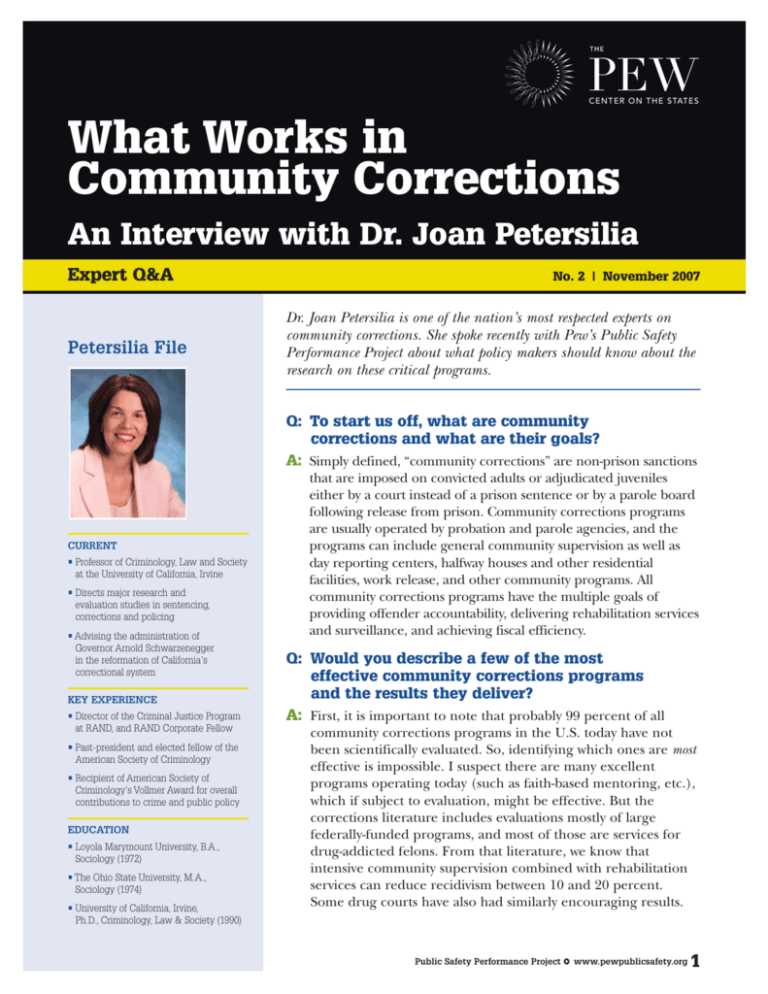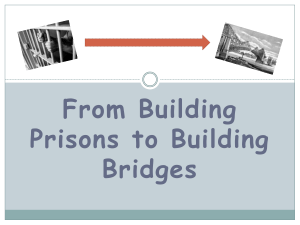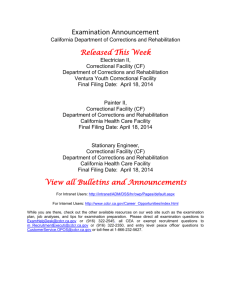What Works in Community Corrections
advertisement

CEN TER ON T H E STAT E S What Works in Community Corrections An Interview with Dr. Joan Petersilia Expert Q&A Petersilia File No. 2 | November 2007 Dr. Joan Petersilia is one of the nation’s most respected experts on community corrections. She spoke recently with Pew’s Public Safety Performance Project about what policy makers should know about the research on these critical programs. Q: To start us off, what are community corrections and what are their goals? A: Simply defined, “community corrections” are non-prison sanctions CURRENT • Professor of Criminology, Law and Society at the University of California, Irvine • Directs major research and evaluation studies in sentencing, corrections and policing • Advising the administration of Governor Arnold Schwarzenegger in the reformation of California’s correctional system KEY EXPERIENCE • Director of the Criminal Justice Program at RAND, and RAND Corporate Fellow • Past-president and elected fellow of the American Society of Criminology • Recipient of American Society of Criminology’s Vollmer Award for overall contributions to crime and public policy EDUCATION • Loyola Marymount University, B.A., Sociology (1972) • The Ohio State University, M.A., Sociology (1974) • University of California, Irvine, Ph.D., Criminology, Law & Society (1990) that are imposed on convicted adults or adjudicated juveniles either by a court instead of a prison sentence or by a parole board following release from prison. Community corrections programs are usually operated by probation and parole agencies, and the programs can include general community supervision as well as day reporting centers, halfway houses and other residential facilities, work release, and other community programs. All community corrections programs have the multiple goals of providing offender accountability, delivering rehabilitation services and surveillance, and achieving fiscal efficiency. Q: Would you describe a few of the most effective community corrections programs and the results they deliver? A: First, it is important to note that probably 99 percent of all community corrections programs in the U.S. today have not been scientifically evaluated. So, identifying which ones are most effective is impossible. I suspect there are many excellent programs operating today (such as faith-based mentoring, etc.), which if subject to evaluation, might be effective. But the corrections literature includes evaluations mostly of large federally-funded programs, and most of those are services for drug-addicted felons. From that literature, we know that intensive community supervision combined with rehabilitation services can reduce recidivism between 10 and 20 percent. Some drug courts have also had similarly encouraging results. Public Safety Performance Project Q www.pewpublicsafety.org 1 What Works in Community Corrections: An Interview with Dr. Joan Petersilia No. 2 | November 2007 Q: And what does the research say about ineffective programs? A: We know more about what doesn’t work than what does. The Pew Charitable Trusts 1025 F Street, NW Suite 900 Washington, DC 20004-1409 www.pewtrusts.org ABOUT THE PROJECT Launched in 2006 as a project of Pew's Center on the States, the Public Safety Performance Project seeks to help states advance fiscally sound, data-driven policies and practices in sentencing and corrections that protect public safety, hold offenders accountable, and control corrections costs. The Pew Charitable Trusts applies the power of knowledge to solve today’s most challenging problems. Our Pew Center on the States identifies and advances effective policy approaches to critical issues facing states. ABOUT THIS BRIEF This document is part of a series of primers for policy makers about the critical choices they face in developing strategies to protect public safety, hold offenders accountable and control corrections costs. For more on this topic, visit our website at www.pewpublicsafety.org “...effective corrections programs must get the right offender in the right program.” Research has shown that boot camps, house arrest, and routine probation and parole supervision do not reduce recidivism. But again, the majority of community corrections programs have never been scientifically tested so you have to view these results cautiously as well. Q: In your view, what are the principles or themes that run through effective community corrections programs? A: At the core of any good community corrections program is the use of an objective risk and needs assessment. Assessments allow correctional agencies to assign offenders to the programs that will most likely benefit them. The “risk” part of the assessment instrument assesses risk to reoffend, and that information is critical to assigning probationers or parolees to levels of surveillance and supervision, such as specialized caseloads, frequent drug testing or electronic monitoring. The “‘need” portion of the assessment instrument identifies the subset of the offender population that research has shown will benefit from being in rehabilitation treatment programs. Research has shown that for high and moderate risk offenders, participation in treatment programs and services has high payoff, but for those with a low risk to reoffend, life skills programs are more appropriate. This is the most efficient use of scarce correctional resources as well as the best way to increase public safety. Of course, the next core principle is to make certain that the rehabilitation programs are of sufficient quality to make a difference. There are now several scoring methods that rate the quality of rehabilitation programs along such dimensions as staff qualifications and training, use of a tested curriculum or program model, and use of cognitive-behavioral or social learning methods. These and other program characteristics have been shown to increase success. In short, effective corrections programs must get the right offender in the right program. And then of course, we must continually evaluate costs and program outcomes and revise accordingly. Research over the last several decades also reinforces the importance of the community and familial supports as sources of informal social control. Effective programs involve family and community members in a very real and proactive way. Effective programs recognize that government programs ultimately end, and the hand-off between the formal and 2 Public Safety Performance Project Q www.pewpublicsafety.org What Works in Community Corrections: An Interview with Dr. Joan Petersilia No. 2 | November 2007 informal systems is ultimately what determines success. In my opinion, community corrections agencies that collaborate closely with non-profits and other community organizations, who in turn work to integrate the offender’s family and social support system, will have the most success. “...it is not one or the other: build prisons or support community corrections. We need strong systems of each.” Q: How have community corrections programs changed and what does the future hold? A: There are two major trends that I see in community corrections today. The first has to do with technology to monitor compliance with court-ordered conditions, such as drug testing, global positioning systems, alcohol breathalyzers, and so on. The second has to do with “wrap-around services.” Every agency, including probation and parole, recognizes that reducing criminal behavior is incredibly difficult and no one agency can do it alone. More and more, I see wrap-around services, where mental health, alcohol and drug abuse, housing, and medical services agencies are planning an offender’s case management plan together. This is very promising. And then, of course, there is reentry, which is now the new correctional buzzword. If inmate reentry were our focus, then the divide between incarceration and community corrections would begin to blur, and that would be a good thing, in my view. Q: Saving the best for last, what are the key questions policy makers should be asking when they confront decisions about correctional strategy and spending? How should they think about striking the right balance between building more prisons and expanding community corrections? A: To me, policymakers need to understand that it is not one or the other: build prisons or support community corrections. We need strong systems of each. We need to create enough prison space to house the truly violent and those with no desire to change their criminal behavior and, at the same time, we need to invest heavily in helping offenders who are not yet steeped in criminal behavior and wish to chart a different path. Sending someone to prison should be our last resort – it is expensive, it is stigmatizing, and it can increase risk for future criminal behavior. Moreover, it impacts not only the person incarcerated but also his or her family and children. Investing in quality community corrections programs is, in my view, just good public policy. Public Safety Performance Project Q www.pewpublicsafety.org 3





